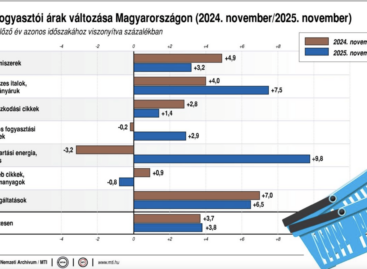Waiting strategy – and no real confidence
In a quarterly online presentation by PwC Magyarország partner Gábor Farkas and Ákos Kozák, a economic research director expert of the Equilibrium Institute has revealed: at the beginning of 2025 analysts forecasted a 2.2% GDP growth, but this may now slip below 2%. In February industrial production fell by 8.7% compared to the previous year.
This article is available for reading in Trade magazin 2025/6-7.
We continue to economise
Hungarians remain keen to save – Hungary ranks second in Europe after Switzerland in terms of the proportion of households with savings. At the same time consumption is still growing, driven primarily by demand for services rather than durable consumer goods. Household cash reserves reached HUF 9,000bn by the end of 2024. The foreign trade balance won’t contribute to growth this year. At the beginning of 2025 the number of people in employment fell by 30,000-40,000 compared to the previous year and the unemployment rate stood at around 4.5%. Although companies are trying to retain their employees, even with lower capacity utilisation in many cases, the decline in hours worked and the lack of growth are warning signs.

Ákos Kozák (Equilibrium Institute) and Gábor Farkas (PwC) emphasize: what is said does not reflect the official position of PwC, but is a non-political, friendly, yet professional exchange of personal views
Inflation estimates move upward
Inflation forecasts have also been revised: while in January the rate was still expected to be around 4%, the new estimates are now in the 4.5-5% range, and the Central Bank of Hungary also expects the 2025 figures to be in this interval. The forint’s exchange rate is currently hovering around the previously indicated level of EUR 410-420, with no significant movement expected for the time being, and its value against the dollar is also stable (310-320). Businesses are waiting, hoping that a sustained upturn in domestic consumption will eventually restart investment and gradually tighten the labour market.
Related news
Nestlé invests GBP 28m in British instant coffee factory
🎧 Hallgasd a cikket: Lejátszás Szünet Folytatás Leállítás Nyelv: Auto…
Read more >A SPAR tovább fejleszt: több mint egymilliárdos modernizációval nyílt újra két budapesti szupermarket
🎧 Hallgasd a cikket: Lejátszás Szünet Folytatás Leállítás Nyelv: Auto…
Read more >21st European Commerce Day: the market and politics sitting at the same table
🎧 Hallgasd a cikket: Lejátszás Szünet Folytatás Leállítás Nyelv: Auto…
Read more >Related news
The Hungarian Confederation of Economic Workers also spoke out regarding the inflation data
🎧 Hallgasd a cikket: Lejátszás Szünet Folytatás Leállítás Nyelv: Auto…
Read more >KSH: in November, consumer prices exceeded the values of the same month of the previous year by an average of 3.8 percent
🎧 Hallgasd a cikket: Lejátszás Szünet Folytatás Leállítás Nyelv: Auto…
Read more >In addition to jelly and marzipan Christmas candy, there are more and more specially flavored Christmas desserts on offer
🎧 Hallgasd a cikket: Lejátszás Szünet Folytatás Leállítás Nyelv: Auto…
Read more >






